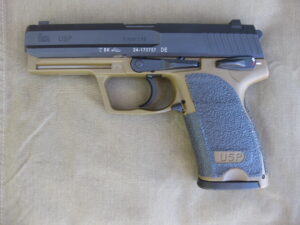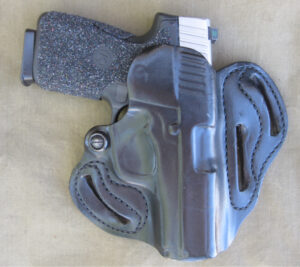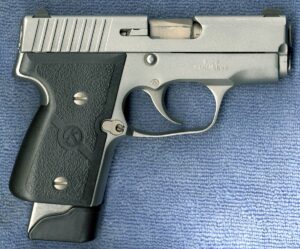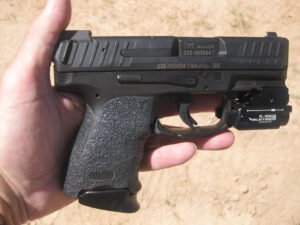
Allow me to begin this article by stating that to date, I have NEVER experienced a stoppage or a malfunction of ANY KIND with any of the 17 different variants of Heckler and Koch Pistols in 9mm, .357 SIG, .40 S&W and .45 ACP caliber that I have field tested, trained with and carried. This includes various HK pistols with a DA/SA, Light LEM and a Striker Fired trigger system. I have also never experienced a stoppage, or a malfunction of any kind, with any of the 9mm HK MP 5 submachine gun variants that I have tested and trained with.
In this T&E Review for the Talon Gun Grips On Line Blog and Newsletter we will be discussing my findings, after field testing the 9mm HK P30 SK (Sub Compact) Pistol with a Light LEM Trigger and the Striker Fired HK VP9 SK (Sub Compact). Both of these pistols were evaluated before and after Talon Rubber Grips were installed on these firearms. This evaluation was conducted in this fashion to determine if the installation of Talon Rubber Grips improved ergonomics and if it did, to what extent were ergonomics improved.
THE HK LIGHT LEM TRIGGER & THE HK STRIKER FIRED TRIGGER
For those of you who are unfamiliar with HK trigger options, the Light LEM or Law Enforcement Module has a super smooth and very light Double Action style of trigger travel, that transitions to a striker fired style trigger just before the pistol is discharged. Another way to put this, is to say, the HK Light LEM Trigger produces a very user friendly cadence that enables the operator to set up the shot, while the trigger is being cycled to the rear. At the end of this short, smooth and very consistent Double Action style trigger pull, the operator will engage a striker fired style trigger to fire the pistol.
The trick to shooting any HK pistol with a Light LEM trigger is to hold your sights on the target, as you transition from the DA style trigger to the more striker fired style part of this system. Simply put, the HK Light LEM combines the finer points of a light weight Double Action trigger with the shorter travel style crispness of a well made Striker Fired trigger system.While the 9mm HK P30 SK model that was included in this review was fitted with a Light LEM Trigger, the VP9 SK Sub Compact was fitted with a striker fired trigger. Because I already own a 9mm HK P30 with a Light LEM Trigger, I opted to purchase the 9mm P30 SK Sub Compact with a Light LEM Trigger, so both my P30 variants would have compatible trigger systems. That said, after testing the HK VP9 SK with the striker fired trigger, I tried in vain to get my buddy Rick Batory to sell me his pistol. In fact, I rate the HK Light LEM Trigger and the HK Striker Fired Trigger to be two of the absolute best triggers in the firearms industry. Part of the reason for this is because both the P30 and the VP9 series have excellent ergonomics. Just like the full size HK P30 and the VP9, the SK or Sub Compact Models include different size backstraps, as well as add on side panels that are designed to provide subtle changes in ergonomics. It’s the combination of excellent ergonomics, a superb trigger system and an outstanding set of night sights that makes a pistol perform to the highest standards possible.
NIGHTS SIGHTS
When the 9mm HK P30 SK Law Enforcement Model was unavailable, HK sent me a standard HK P30 SK that did not come with night sights. I rectified this situation by ordering a set of three dot Trijicon Bright and Tough Model Night Sights (HK10) that has the Front Sight fitted with a white outline and green Tritium insert and a Rear Sight fitted with a white outline and green Tritium insert. I selected this particular set because whenever I install Trijicon night sights on any of my pistols, I use the type that has a white outline with a green Tritium insert. Operating in this fashion enables me to have the same sight picture when I engage targets. Unfortunately, due to the unprecedented demand on all firearms related products, I wasn’t able to take delivery of a set of my favorite Trijicon Night Sights for my P30 SK before finishing this article. That said, once these night sights arrive, my 9mm P30 SK will be equipped with a set of Trijicon HK10s. (The HK VP9 SK that is featured in this T&E review was equipped with a set of Meprolight Tru-Dot Night Sights.)
DO TALON GUN GRIPS MAKE A DIFFERENCE
As someone who has written a number of articles for the Talon Gun Grips Blog and Newsletter, it is no secret that I am a huge fan of Talon Rubber Grips. The reason this is the case, is because I have noticed a marked improvement in ergonomics, when I field test a pistol that is fitted with a set of (add on) Talon rubber grips, as opposed to shooting a pistol with a standard factory grip. This became evident when I fired my 9mm P30 and my 9mm P30 SK before and after a set of Talon Rubber Grips were installed on these pistols. This is quite a compliment to Talon, because the HK P30, the P30 SK, the HK VP9 and the VP9 SK come from the factory with excellent ergonomics.
Installing a set of Talon Rubber Grips improves on perfection and provides a more secure gripping surface that also softens the recoil impulse that is generated into the shooter’s hand. I wasn’t the only person who noticed this. According to Retired School District Patrol Sergeant Rick Batory, he noticed this as well, especially when conducting rapid fire drills with his VP9 SK Sub Compact. I confirmed this to be true after I tested Rick’s VP9 SK that was equipped with a set of Talon Rubber Grips and when I tested a 9mm P30 SK model, while using a standard factory grip and after a set of Talon Rubber Grips were installed on this pistol.
ACCURACY
The 9mm P30 SK and the VP9 SK are clearly capable of delivering precision shot placement as long as the shooter holds up their end. Two of the best ways to determine the accuracy of a particular firearm is to engage paper targets at different distances from a standing unsupported position and engaging one or more metal plates at a faster pace. During testing, both of these pistols proved to be very easy to shoot accurately while using 124 and 147 grain 9mm Federal, Speer and Aguila FMJ ammunition, as well as 124 grain 9mm Federal HST HP ammo and 124 grain 9mm Speer Gold Dot HP ammo.
For all of the reasons listed in this test and evaluation, I consider the 9mm HK P30 SK Sub Compact Pistol with a Light LEM Trigger and the striker fired 9mm HK VP9 SK Sub Compact to be two Top Guns for concealed carry. Did one HK SK Model impress me more than the other? The simple truth is, I liked them both and will likely end up buying a 9mm VP9 SK at some point. In fact, if I could only own one pistol it would be an HK.
CLOSING REMARKS
While all types of Talon Grips improve ergonomics, applying a pair of Talon PRO Grips and Talon Granulate style Grips provides a more aggressive gripping surface on your pistol. Having this capability can enable you to hold onto your firearm with wet, sweaty or bloody hands. You can also soften the impact of recoil by installing a set of Talon Rubber Grips on a handgun. This is something that I have had to deal with, after decades of shooting all types and calibers of firearms. (Getting older hasn’t helped.) As a result, I know from experience, that installing a set of Talon Rubber Grips on a handgun can make shooting a more comfortable experience.
The author is a Medically Retired U.S. Customs Agent and a former NY Police Officer who was physically disabled in the line of duty while working undercover as a federal agent. To date, the author has published over 180 magazine articles and nine books.


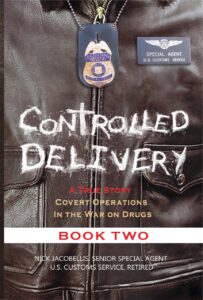




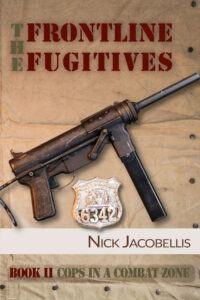









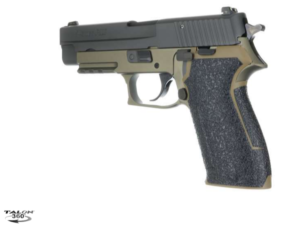



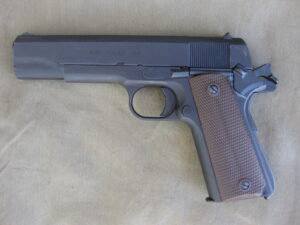
 The first thing that you notice when you examine the Auto Ordnance 9mm 1911, is the high quality of the fit and finish of this firearm. Your impression of the Auto Ordnance 9mm 1911 will soar even higher, when you rack the slide for the first time. This pistol is so easy to operate, I actually wondered if the recoil spring was strong enough to cycle the slide, when this firearm was fired. I mention this, because anyone who has test fired various pistols knows from experience, that some makes and models have noticeably heavy recoil springs. This is not the case with the Auto Ordnance 9mm 1911.
The first thing that you notice when you examine the Auto Ordnance 9mm 1911, is the high quality of the fit and finish of this firearm. Your impression of the Auto Ordnance 9mm 1911 will soar even higher, when you rack the slide for the first time. This pistol is so easy to operate, I actually wondered if the recoil spring was strong enough to cycle the slide, when this firearm was fired. I mention this, because anyone who has test fired various pistols knows from experience, that some makes and models have noticeably heavy recoil springs. This is not the case with the Auto Ordnance 9mm 1911. The Auto Ordnance 9mm 1911 is a pleasure to shoot on a sustained basis and is ideally suited for use by anyone, who is challenged by using a pistol fitted with a heavy recoil spring. The soft shooting nature of this pistol also makes the 9mm 1911 an excellent training pistol for novice shooters.
The Auto Ordnance 9mm 1911 is a pleasure to shoot on a sustained basis and is ideally suited for use by anyone, who is challenged by using a pistol fitted with a heavy recoil spring. The soft shooting nature of this pistol also makes the 9mm 1911 an excellent training pistol for novice shooters.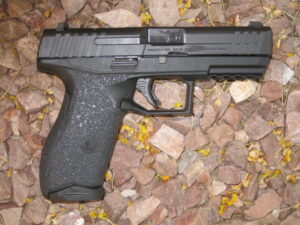 The 9MM IWI Masada
The 9MM IWI Masada


